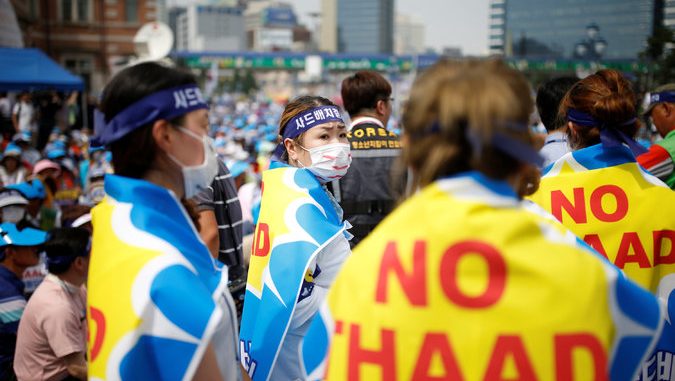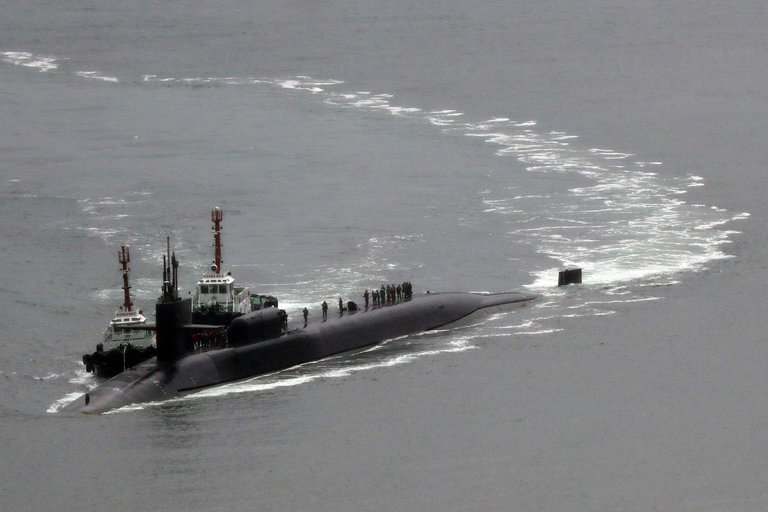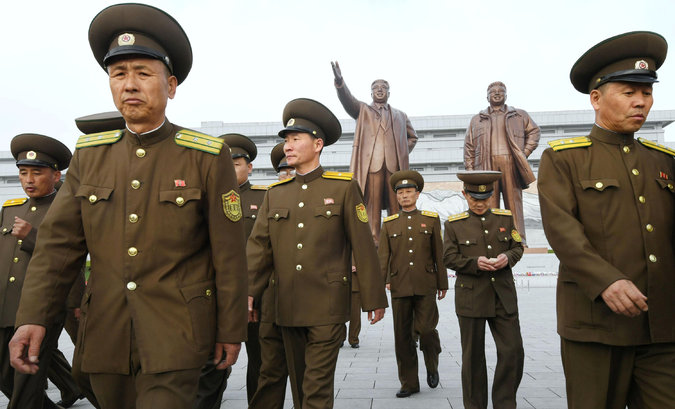
Opposition head, likely new Premier, calls US & lame-duck Seoul regime rapid deployment attempted “fait accompli” before May 9 elections. Fierce protests by local villagers & activists arose quickly on Wednesday in Seongju, site of deployment. Sirens wailed to alert villagers as a convoy of US military vehicles carrying the radar, launchpads, interceptor missiles and other key parts of the THAAD system pulled into town. Hundreds of villagers rushed out, shouting slogans against THAAD and blocking the road. But more than 8,000 South Korean police officers overpowered them, removing protesters and their cars from the road to let the military vehicles pass on their way to abandoned golf course, site of the deployment. Top, South Korean anti-THAAD protesters. Below, guided missile submarine Michigan at a base in Busan, South Korea, on Tuesday. Its presence reflected heightened military readiness on both sides of the Korean Peninsula.
The United States and South Korea began installing key elements of an advanced missile-defense system in a rural southern county on Wednesday,
a day after North Korea held huge artillery drills to mark the 85th anniversary of the founding of its military.
Work on the Terminal High Altitude Area Defense system, also known as THAAD, got underway in Seongju, 135 miles southeast of Seoul,
while China, which strongly opposes the Thaad system, continued to try to tamp down tensions over signs that North Korea was preparing for a nuclear test.
It remained unclear whether the installation was ahead of schedule;
Washington and the lame-duck Seoul government have said only that they want THAAD operational “soon” or “within this year.”
The deployment has become a key issue in the campaign for the May 9 election to choose the successor to former President Park Geun-hye,
who had agreed to the deployment but was forced from office in disgrace last month.
Moon Jae-in, an opposition leader who is leading the polls, has vowed to review Ms. Park’s agreement if he is elected.
He accused the United States and South Korea earlier of rushing the deployment to make it “a fait accompli” before a new leader takes office in Seoul.
South Korea remains deeply divided over THAAD, which both Washington and Seoul say is
intended to defend South Korea and American troops there from North Korea’s fast-growing nuclear and ballistic missile threats.
In Seongju, fierce protests by local villagers and activists arose quickly on Wednesday.
Sirens wailed to alert villagers as a convoy of US military vehicles carrying the radar, launchpads, interceptor missiles and other key parts of the THAAD system pulled into Seongju.
Hundreds of villagers rushed out, shouting slogans against THAAD and blocking the road.
But more than 8,000 South Korean police officers quickly overpowered them,
removing the protesters and their cars from the road to let the military vehicles pass on their way to an abandoned golf course, the site of the deployment.
North Korea’s long-range artillery drills were conducted near Wonsan, along the country’s east coast, according to the South Korean military.
They coincided with military maneuvers by the United States and its allies,
as well as the arrival of the Michigan, a submarine armed with Tomahawk cruise missiles, in the port city of Busan, South Korea.
The United States Navy described the arrival of the submarine as “routine,”
but its presence reflected the heightened military readiness on both sides of the Korean Peninsula.
And on Wednesday, the Navy’s Seventh Fleet said that a strike group led by the aircraft carrier Carl Vinson was conducting exercises with Japanese forces in the Philippine Sea.
In addition to holding joint naval exercises in the Yellow Sea,
US and South Korea have been staging military maneuvers in Pocheon, northeast of Seoul, demonstrating some of their latest weapons.
A North Korean state newspaper, Rodong Sinmun, said last week that
the joint maneuvers were taking the tense situation on the peninsula to the “verge of explosion.”
North Korea often uses important national holidays, like the anniversary on Tuesday, to display its military might.
On April 15 — which would have been the 105th birthday of Kim Il-sung, the country’s founder —
it held a large military parade, flaunting what analysts said could be new intercontinental ballistic missiles.
The next morning, it launched a ballistic missile that failed after liftoff.
North Korean soldiers in front of statues of country’s founders Kim Il-sung and Kim Jong-il,, in Pyongyang, the capital, on the day of massive artillery drills. Credit Kyodo, via Reuters
The South Korean news agency Yonhap, citing an unidentified government source, said
the North Korean exercise involved 300 to 400 pieces of long-range artillery, of the same type deployed along the border north of Seoul.
Seoul, a city of 10 million, lies in range of the North Korean artillery and could experience catastrophic damage if war broke out.
Yonhap called the drill one of the largest live-fire exercises conducted by the North.
South Korea said Monday that it had developed radar that can detect incoming artillery faster and more accurately than the radar it now uses.
The Defense Acquisition Program Administration said the technology, to be deployed by 2018, would not enable the South to intercept the rockets
but would allow the military to identify their source more efficiently and strike the launchpads.
On Tuesday, China sent Wu Dawei, a longtime diplomat handling tensions on the Korean Peninsula, to Tokyo
for talks with Japanese Foreign Ministry officials in hopes of warding off military confrontation.
Source: Missile Defense System Takes Shape in South Korea as North Holds Drills – The New York Times

